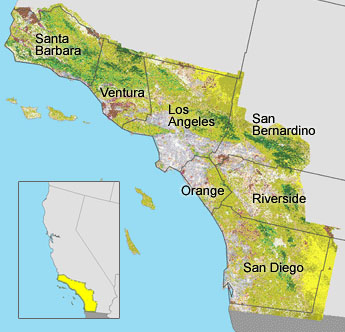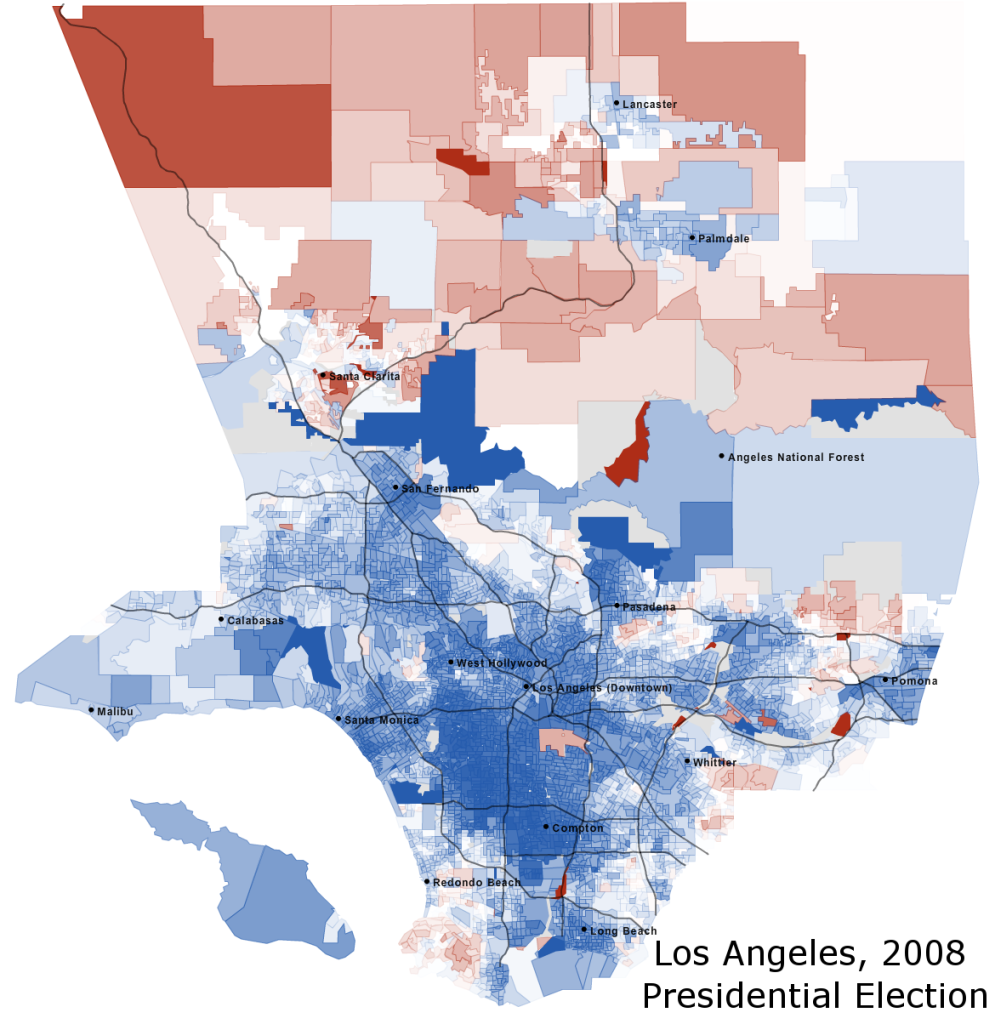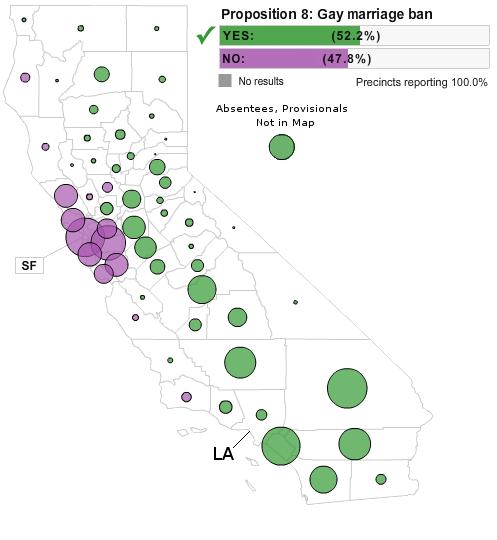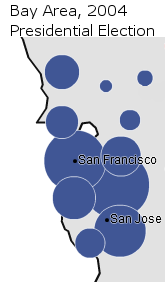Here is Part 2 of my analysis of this fall’s elections in California, which will cover the Congressional races. Part 3 will cover the state legislature.
Cross-posted at Swing State Project, Daily Kos, and Democracy for California.
Incumbents are in boldface. In the case of open seats, the party of the retiring incumbent is listed without boldface.
D: Democratic
R: Republican
L: Libertarian
G: Green
AI: American Independent
PF: Peace and Freedom
SW: Socialist Workers
I: Independent
Senator:: Barbara Boxer (D) vs. ex-HP CEO Carly Fiorina (R), Duane Roberts (G), Gail Lightfoot (L), Edward Noonan (AI), Marsha Feinland (PF), James Harris (SW-W/I)
Even after Arnold decided against running, and long before “Coakley” became a verb, I expected Boxer to be in a tough fight in 2010. Fortunately, she is no slacker and knows how to run a tough campaign, hitting her opponent where it hurts (in this case, on attacking Fiorina’s praise of outsourcing and using former HP employees). She is polarizing, but fortunately the Democratic base in California is big enough for her to win even if she loses independent voters by single to low-double digits.
Outlook: Lean Boxer
U.S. HOUSE (Composition: 34 Democrats, 19 Republicans)
CA-03 (Sacramento suburbs): Dan Lungren (R) vs. Dr. Ami Bera (D), Art Tuma (L), Lerry Leidecker (AI), Mike Roskey (PF)
Registration: 40.31% GOP, 37.55% DEM, 17.72% DTS, 4.42% other
Profile: This is one of the Democrats’ best chances of picking off a GOP-held seat in the House. This suburban Sacramento seat was strongly Republican early in the decade before rapidly swinging left to become an Obama-voting district in 2008, also nearly catching Lungren off-guard. Bera has outraised Lungren every quarter this cycle, and don’t be surprised to see this as one of the closest races in a GOP-held seat.
10/23/2010 Outlook: Toss-up/tilt Lungren
CA-11 (San Joaquin County and parts of East Bay): Jerry McNerney (D) vs. attorney David Harmer (R), David Christensen (AI)
Registration: 39.45% DEM, 39.00% GOP, 17.54% DTS, 4.01% Other
Profile: This was expected since the end of the last cycle to be another challenging race for McNerney, especially after Harmer won the primary. Harmer, as you may remember, made the 2009 special in the more Democratic CA-10 a 10-point race against Garamendi. Fortunately for Harmer, the 11th is much less Democratic and he now has more name recognition. Unfortunately for Harmer, the race in CA-11 will be in a general election rather than an off-year special, so turnout is guaranteed to be higher. Also, the trends in registration are more in McNerney’s favor, flipping to a Dem advantage in registration for the first time, mirroring the trend to the Dems statewide in registration.
10/23/2010 Outlook: Lean McNerney
CA-18 (Upper Central Valley): Dennis Cardoza (D) vs. agribusinessman Mike Berryhill (R)
CA-20 (Fresno, part of Bakersfield): Jim Costa (D) vs. farmer Andy Vidak (R)
CA-18 Registration: 49.85% DEM, 31.81% GOP, 14.32% DTS, 4.02% Other
CA-20 Registration: 51.45% DEM, 31.02% GOP, 12.64% DTS, 4.89% Other
Profile: Not on anybody’s radar screens until about a month ago, the Central Valley is now the source of two more competitive races, with water a hot issue here and the Republicans harping the issue nonstop. The 18th is less Democratic than the 20th, owing to the lack of a major urban center, having gone for Bush narrowly in 2004, but Cardoza is taking his tougher-than-expected reelection more seriously, so I expect Costa to have a slightly tougher reelection than Cardoza.
CA-18 10/23/2010 Outlook: Likely Cardoza
CA-20 10/23/2010 Outlook: Lean to Likely Costa
CA-44 (Riverside, Corona, San Clemente): Ken Calvert (R) vs. educator Bill Hedrick (D)
Registration: 43.11% GOP, 33.87% DEM, 18.38% DTS, 4.64% Other
Profile: One of the out-of-nowhere near-upsets of 2008, Hedrick is back for a rematch. Calvert is trying to avoid being caught asleep at the wheel again, and Hedrick is surprisingly lacking in the money department despite coming very close last time, so I don’t like his chances this time.
10/23/2010 Outlook: Lean to Likely Calvert
CA-45 (Most of Riverside County): Mary Bono Mack (R) vs. Palm Springs mayor Steve Pougnet (D), Bill Lussenheide (AI)
Registration: 41.29% GOP, 38.31% DEM, 16.17% DTS, 4.23% Other
Profile: Democrats got a top-tier recruit here in the openly gay mayor of Palm Springs. Bono Mack has taken heat for her vote against repealing Don’t Ask, Don’t Tell, even though her district has the highest proportion of gays of any Republican-held district, and Lussenheide is challenging her from the right, on some of her “insufficiently conservative” votes such as cap-and-trade. I expect Pougnet to perform better than Bornstein last time, though still come up short.
10/23/2010 Outlook: Likely Bono Mack
CA-47 (Anaheim, Santa Ana): Loretta Sanchez (D) vs. Assemblyman Van Tran (R), Ceci Iglesias (I), Gary Schank (I)
Registration: 46.90% DEM, 30.90% GOP, 18.67% DTS, 3.53% Other
Profile: Like the Central Valley Dem districts, the Orange County Dem district, which also voted for Bush like CA-18, is now a hot race after being off most radar screens until about a month ago. Sanchez didn’t help herself by the gaffe “The Vietnamese are after my seat”, which I thought was really boneheaded, considering all that she had done for them in the past. I still expect Sanchez to win, though by less than against Tan Nguyen from 2006.
10/23/2010 Outlook: Lean to Likely Sanchez
CA-48 (Central Orange County, including Irvine): John Campbell (R) vs. Irvine Councilwoman Beth Krom (D), Mike Binkley (L)
Registration: 44.41% GOP, 28.99% DEM, 22.45% DTS, 4.15% Other
Profile: Once expected to be a top-tier race, this district fell off the radar screen as the touted former mayor of Irvine Beth Krom has lagged on the money front.
10/23/2010 Outlook: Likely Campbell
Safe:
CA-01 (North Coast): Mike Thompson (D)
CA-02 (Northern Sacramento Valley): Wally Herger (R)
CA-04 (Northeast, including Tahoe): Tom McClintock (R)
CA-05 (Sacramento): Doris Matsui (D)
CA-06 (Northern SF Bay): Lynn Woolsey (D)
CA-07 (Northeast SF Bay): George Miller (D)
CA-08 (San Francisco): Nancy Pelosi (D)
CA-09 (Berkeley, Oakland): Barbara Lee (D)
CA-10 (Inner East SF Bay): John Garamendi (D)
CA-12 (Lower SF Peninsula): Jackie Speier (D)
CA-13 (Southern East Bay): Pete Stark (D)
CA-14 (Silicon Valley): Anna Eshoo (D)
CA-15 (Santa Clara, Cupertino): Mike Honda (D)
CA-16 (San Jose): Zoe Lofgren (D)
CA-17 (Northern Central Coast): Sam Farr (D)
CA-19 (Yosemite, part of Fresno): Jeff Denham (R) – vacated by George Radanovich (R)
CA-21 (Tulare): Devin Nunes (R)
CA-22 (Bakersfield): Kevin McCarthy (R)
CA-23 (Southern Central Coast): Lois Capps (D)
CA-24 (Inner Santa Barbara/Ventura): Elton Gallegly (R)
CA-25 (Palmdale, Big Empty): Buck McKeon (R)
CA-26 (Northeastern L.A. suburbs): David Dreier (R)
CA-27 (Western San Fernando Valley): Brad Sherman (D)
CA-28 (Eastern San Fernando Valley): Howard Berman (D)
CA-29 (Burbank, Glendale, Pasadena): Adam Schiff (D)
CA-30 (Malibu, Beverly Hills): Henry Waxman (D)
CA-31 (Hollywood): Xavier Becerra (D)
CA-32 (Covina, Baldwin Park): Judy Chu (D)
CA-33 (Culver City): Karen Bass (D) – vacated by Diane Watson (D)
CA-34 (Downtown L.A.): Lucille Roybal-Allard (D)
CA-35 (South Central): Maxine Waters (D)
CA-36 (Beach Cities): Jane Harman (D)
CA-37 (South Central, Long Beach): Laura Richardson (D)
CA-38 (Southeastern L.A. suburbs): Grace Napolitano (D)
CA-39 (Southeastern L.A. County): Linda Sánchez (D)
CA-40 (Northern Orange County): Ed Royce (R)
CA-41 (Most of San Bernardino County): Jerry Lewis (R)
CA-42 (Chino, Brea): Gary Miller (R)
CA-43 (Ontario, San Bernardino): Joe Baca (D)
CA-46 (Huntington Beach, Seal Beach, Palos Verdes): Dana Rohrabacher (R)
CA-49 (Temecula, Oceanside): Darrell Issa (R)
CA-50 (Northern San Diego suburbs): Brian Bilbray (R)
CA-51 (Imperial County, southern SD suburbs): Bob Filner (D)
CA-52 (Eastern San Diego suburbs): Duncan D. Hunter (R)
CA-53 (San Diego): Susan Davis (D)
 Pundits already discounting the failed Senate candidate
Pundits already discounting the failed Senate candidate





